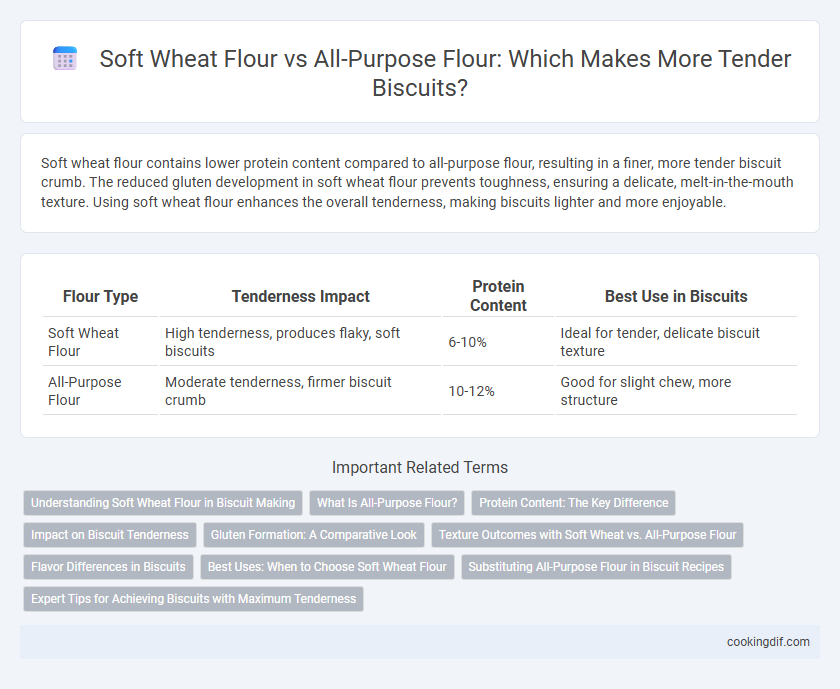Soft wheat flour contains lower protein content compared to all-purpose flour, resulting in a finer, more tender biscuit crumb. The reduced gluten development in soft wheat flour prevents toughness, ensuring a delicate, melt-in-the-mouth texture. Using soft wheat flour enhances the overall tenderness, making biscuits lighter and more enjoyable.
Table of Comparison
| Flour Type | Tenderness Impact | Protein Content | Best Use in Biscuits |
|---|---|---|---|
| Soft Wheat Flour | High tenderness, produces flaky, soft biscuits | 6-10% | Ideal for tender, delicate biscuit texture |
| All-Purpose Flour | Moderate tenderness, firmer biscuit crumb | 10-12% | Good for slight chew, more structure |
Understanding Soft Wheat Flour in Biscuit Making
Soft wheat flour, characterized by its lower protein content (around 7-9%), produces biscuits with a tender, delicate crumb by minimizing gluten development during mixing. This type of flour retains more moisture and creates a finer, softer texture compared to all-purpose flour, which has higher protein content (typically 10-12%) and results in chewier biscuits. Understanding the protein differences and gluten formation in soft wheat flour is key to achieving optimal tenderness in biscuit making.
What Is All-Purpose Flour?
All-purpose flour is a versatile, medium-protein flour typically containing 10-12% protein, making it suitable for a wide range of baking needs, including biscuits. Compared to soft wheat flour, which has lower protein content (about 7-9%) and produces exceptionally tender baked goods, all-purpose flour provides more structure but can yield slightly tougher biscuits. For maximum tenderness, soft wheat flour is preferred, while all-purpose flour strikes a balance between tenderness and durability in biscuit texture.
Protein Content: The Key Difference
Soft wheat flour contains significantly lower protein content, typically around 8-10%, compared to all-purpose flour, which ranges from 10-12%. This reduced protein level in soft wheat flour results in less gluten formation, producing a more tender and delicate biscuit texture. Choosing soft wheat flour over all-purpose flour is essential for achieving optimum softness and crumbly structure in biscuits.
Impact on Biscuit Tenderness
Soft wheat flour contains lower protein content than all-purpose flour, which results in less gluten development and a more tender biscuit texture. Using soft wheat flour enhances biscuit tenderness by producing a finer crumb structure and delicate crumb. All-purpose flour, with higher protein levels, creates firmer biscuits that are less tender compared to those made with soft wheat flour.
Gluten Formation: A Comparative Look
Soft wheat flour contains lower protein content, resulting in reduced gluten formation compared to all-purpose flour, which typically has moderate protein levels. This difference in gluten development directly affects biscuit tenderness, as less gluten leads to a finer, softer crumb. Bakers often prefer soft wheat flour when aiming for biscuits with a delicate, melt-in-the-mouth texture due to its minimal gluten network.
Texture Outcomes with Soft Wheat vs. All-Purpose Flour
Soft wheat flour, with its lower protein content (around 8-10%), produces biscuits with a tender, crumbly texture due to reduced gluten development compared to all-purpose flour. All-purpose flour, containing approximately 10-12% protein, yields a chewier and more structured biscuit texture, often less delicate than those made with soft wheat flour. For achieving optimal tenderness and a melt-in-mouth crumb, soft wheat flour is preferred, especially in recipes prioritizing lightness and softness.
Flavor Differences in Biscuits
Soft wheat flour contributes a more delicate texture and richer, slightly sweet flavor to biscuits compared to all-purpose flour, which produces a sturdier crumb with a neutral taste. The lower protein content in soft wheat flour allows for less gluten development, enhancing tenderness and flavor absorption in biscuits. Using soft wheat flour highlights subtle buttery and nutty notes, making biscuits more flavorful and appealing.
Best Uses: When to Choose Soft Wheat Flour
Soft wheat flour is ideal for recipes requiring a tender, delicate crumb such as biscuits, cakes, and pastries due to its lower protein content compared to all-purpose flour. Its fine texture enhances softness and reduces chewiness in baked goods, making it the best choice when the primary goal is tenderness. Use soft wheat flour for biscuits when a light, melt-in-the-mouth texture is desired, especially in recipes that do not need strong gluten development.
Substituting All-Purpose Flour in Biscuit Recipes
Soft wheat flour, with its lower protein content compared to all-purpose flour, enhances biscuit tenderness by producing less gluten, resulting in a softer, more delicate crumb. Substituting all-purpose flour with soft wheat flour in biscuit recipes can significantly improve texture without compromising structural integrity. This substitution is ideal for achieving melt-in-the-mouth biscuits that maintain enough strength to hold their shape during baking.
Expert Tips for Achieving Biscuits with Maximum Tenderness
Soft wheat flour contains lower protein content than all-purpose flour, resulting in less gluten development, which enhances biscuit tenderness. For biscuits with maximum tenderness, experts recommend using soft wheat flour or combining it with all-purpose flour to balance structure and softness. Handling the dough gently and minimizing mixing further preserves the delicate texture achieved by using soft wheat flour.
Soft wheat flour vs all-purpose flour for tenderness Infographic

 cookingdif.com
cookingdif.com